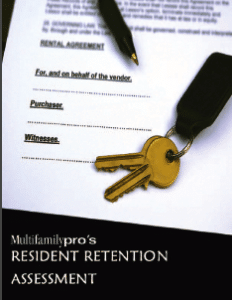Resident Retention Plan
By Tami Siewruk
Step One: Assess Your Current Resident Retention Efforts

Before reading on complete the following four items:
One:Send an email to tami@multifamilypro.com so that I can send you the Resident Retention Assessment tool
Two: Take the time to download the retention tool and print.
Three: Complete the Resident Retention Assessment form. Remember to assess your efforts honestly.
This post isn’t going anywhere, I’ll wait while you complete the above steps! Smiles….
Finished? Ok, let’s move forward.
If you answered No/Never, or Somewhat/Sometimes, more often than Yes/Always, you need to make a change.
The next step will lead you to develop specific goals and objectives toward improving your current efforts. Naturally, improving the trouble spots will be your most difficult task. Keep them in mind, and let’s move on to step two.
Step Two: Obtain Commitment and Develop the Resident Retention Plan
A little synergy is required here, because you’re really taking two steps at once. You can’t have a successful plan without commitment, and you can’t easily obtain commitment without a defensible plan. The key is in taking it one small step at a time, obtaining commitment first for resident retention as a concept, then for a comprehensive plan to make it happen. You’ll need the support of your entire management structure, and I’m certain you’ve learned from experience that support only comes when you’ve covered all the bases. Not only will you have to develop a clear and comprehensive vision for your company or community, but you’ll have to communicate your mission to your team as well. You’ll need a concise mission statement that tells the team, in no uncertain terms, what you are trying to accomplish. You’ll also need clearly defined goals and objectives, so each member of the team can say, “This is my contribution to our resident-retention mission.”
Your vision might be to achieve 78 percent of potential renewals during the coming calendar year. You must be realistic here.
Your mission statement might read: “We, the management and staff of ____ Apartments, dedicate ourselves to ensuring that 78 percent of our eligible residents renew their leases during the ____ calendar year. We plan to ensure that our goal is met through increased commitment to resident retention as a concept, and by taking every opportunity to prove to our current residents that we can, do, and will offer superior service and support to that of our competitors.
Goals and objectives might include improved maintenance response times; better and more frequent resident activities; the addition of a new amenity; and improved interpersonal relations between residents and staff, along with the specific tasks required to achieve them.
In summary, obtain the complete commitment of your management structure by providing a well-conceived plan that includes a clear and comprehensive vision. Show them you’ve got the bases covered by providing a concise mission statement, along with specific goals and objectives toward achieving that mission.
Now, team involvement is your most important resource, because you’re only halfway there. The next five steps will be targeted at gathering the necessary information to make your plan really work. Follow each of the next five steps with a review of your goals and objectives as a team effort. Make changes and additions as necessary to flesh them out and make them truly effective. The devil really is in the details, but so is your ultimate success.
Step Three: Get to Know the Residents
If you think you don’t have the time, you might as well give it up right here and now. If you think you already know your residents, trust me when I say you don’t know them well enough right now to ensure the success of your plan. Face up to the fact that you’ll have to dedicate a little time and effort here, but I promise that the rewards will be HUGE! You absolutely need to know what your residents like and dislike about you, your team, your community, and their apartments. You have to know what their needs are, what they would like to see changed, what their expectations are, and what will satisfy them. In short, you have to know everything there is to know and exactly what they expect you to do in order to maintain their residency. Get on the telephone and talk to them! Don’t wait start making calls today.
Often residents find it difficult to voice their expectations. They know good service when they get it,but they are hard-pressed to define it for you. There are two key things that residents consider when deciding whether or not to renew their lease with you.Understanding those considerations can help you better define your vision of superior service:
Good service is paramount. If a resident expects nothing else, he or she expects to be treated with courtesy and respect, and to have problems addressed pro actively and promptly. They won’t stop and ask themselves whether or not you responded to their needs appropriately. They’ll just remember instances where you did or didn’t. Believe me–they’ll remember.
Though actually a tenet of superior service,the attitude of the community’s staff is often considered alone. Restrictive policies are a sure turn-off, as are good, old-fashioned bad attitudes. Again,they won’t actually ask themselves whether or not your staff and policies are supportive, pleasant, caring, convenient, and beneficial. They’ll consider specific instances where your staff went out of their way to assist or failed to do so. Remember that they expect courtesy and respect. They’ll remember the positive support if you go out of your way to make it a memorable experience, but they’re more likely to remember a lack of support. They’ll remember when they were placed in an inconvenient situation and told, “That’s our policy.” They’ll remember coming to you with a problem and being ignored or left hanging.
Now, with these considerations in mind, you must be prepared to go one step further. Though you know them as “residents,” it’s time to get to know them as “personalities.” The most effective way to find out exactly what you need to know about your residents is simply to ask. Call them, visit them, or survey them. You have a few options at your disposal, but whatever the means, be certain to get the whole message. We don’t like to hear what’s bad or wrong, and residents often find it difficult to convey negative messages. The fact is that you need to hear the negative messages even more than you need to hear the positive ones. If you’re going make them want to stay, you’ll probably have to make a few changes. On the same note, “if it ain’t broke, don’t fix it” is a fine approach to take–but even if it ain’t broke, it might need a little improvement all the same. This is not a test, so be certain they understand that your goal is to find out wh at you can do to add value to their quality of life at your community. Keep an open mind and an open ear.
Gosh, I hope you are taking my advice! Trust me on this you will be rewarded in more ways than one! Your community and your career will benefit!!!!!!!!!!!!
I am laughing at myself as I type; I have so much passion to make certain you succeed. Alright, I’ll get off my soapbox and move on.
Step Four: Set Standards of Performance
Every effective plan or strategy includes standards for measuring success. You have two choices: You can wait until the end of the year to see if you achieved your vision by accident, or you can build in measures of effectiveness all along the way to ensure success. We know that your are smart enough to choose the second option, let’s look at ways to gauge the success of your efforts. Start by setting a specific and realistic goal. Don’t just say, “We need improved maintenance response times.” Say, “We need to reduce maintenance response times from an average of 48 to 24 hours.” Choose objectives that specifically contribute to achieving the goal. Then spread your efforts over performance periods, and form a schedule to gather status information for each period.
To make the measurement process a little more manageable, you may consider forming “Tiger Teams” to address specific goals and objectives. Holding periodic “Program Review”meetings, at which team leaders present the status of their specific tasks, can help. This serves two purposes. First, assigning responsibilities will help ensure that team members “buy in” to the concept. Secondly, sharing status as a group will help the other team members understand where their efforts fit into the overall scheme.
You’ll likely be reviewing maintenance response times; attendance at community activities; and the number of resident complaints and move-out notices, to name just a few factors. It maybe more practical to measure some weekly and others monthly or quarterly. It may seem like business as usual, only you won’t just be gathering information for your regular reports. You’ll be looking for specific ways to make the numbers better, faster, and more effective. After a while, each goal will begin to take on a life of its own, not only contributing to your resident-retention vision, but also starting a chain reaction that channels innovative solutions to every facet of your day-to-day operations. It may seem overwhelming at times. The key to managing the feedback that you’ll be receiving is to view each goal in the context of its specific standard of success.
Now that I’ve told you to concentrate on making the numbers better, faster, and more effective, I should caution you to avoid improvement for improvement’s sake where numbers are concerned. Look for ways to measure success that aren’t purely statistical.Survey your residents, attend the community events yourself, and pay attention to the word-of-mouth. Share your findings, and instruct your staff to do the same. Remember that your first responsibility is to your resident’s quality of life, and your goal is to make them want to stay. You may be able to reduce maintenance response time from 48 to 24 hours, but can you do it without compromising the quality of service? If you can’t, take another look at your goals and objectives. If you can, go for it. In either case, lessons learned in one area can be applied to many others. If you made a bad choice in one area,look at all the others to make sure you’re not making the same mistake again.If you did something right, maybe you can apply the same winning technique to another goal. A successful plan is a work in progress.
The benefits extend beyond simply ensuring the success of your plan. When every member of your team is involved in finding better and more effective ways to do their jobs, the benefits will multiply exponentially. When you set standards for what are considered ordinary practices, you’ll get superior performance from your team.Remember, “What gets measured, gets done.”
I am ending here; you have a lot of actions to complete! My next post will give you the final steps to complete your plan!



Recent Comments